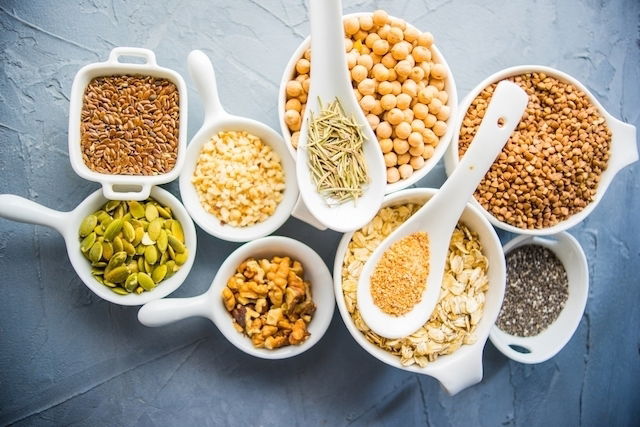High fiber foods are important for many bodily functions, like preventing constipation, regulating blood sugar and eliminating toxins in the body. Wheat bran, cabbage, avocado and almonds are examples of foods that can easily be incorporated into your daily diet.
Fiber is a type of carbohydrate that is not absorbed by the body. It can be naturally found in fruit, vegetables, legumes, and grains. The daily recommended amount of fiber for adults is between 25 and 38 grams.
There are two types of fiber: soluble and insoluble. Most high fiber foods contain both types, although each have different health benefits. Soluble fiber, for example, helps to regulate blood glucose levels and increases satiety, which helps to manage diabetes and obesity.

List of high-fiber foods
The following table contains food that is rich in fiber and the they have:
Health benefits
In general, the health benefits of fiber are:
1. Preventing constipation
Fiber speeds up bowel movements, increases the amount of stool produced, and eliminates it more easily, especially when the fiber is consumed with adequate amounts of water.
2. Keeping you full
Because fiber is not digested, it creates a type of gel in the stomach, which helps reduce the number of calories ingested and thus facilitates weight loss;
3. Regulating blood sugar levels
Absorption of fiber in the intestines is slower, which makes glucose increase at a slower rate, allowing insulin time to act.
4. Decreasing cholesterol and triglycerides
Fiber can decrease the absorption of fat and cholesterol from the intestines into the body, which leads to decreased concentrations in the blood.
5. Eliminating toxins
The body uses fiber as a natural defense mechanism to get rid of toxins that are found in the gut. These toxins are eliminated through the stool. Fiber also regulates and controls the intestine’s pH.
6. Maintaining gut health
Fiber feeds the good bacteria that are naturally present in the intestines. As well as promoting the health of the gut microbiota, fiber reduces inflammation, increases body defenses, and avoids the development of intestinal diseases.
In order to really benefit from a fiber-rich diet, the best thing to do is to have high fiber food every day, as a part of all main meals and snacks. Another important aspect of this type of diet is that you need to up your water intake, as water hydrates the fiber and lubricates the intestines, which helps the body to get rid of stool more easily and this prevents constipation.
Main types of fiber in foods
Dietary fiber can be classified as soluble or insoluble. The main difference between them is that soluble fiber dissolves in water, while insoluble fiber doesn’t. Each one has benefits.
1. Soluble fibers
Soluble fibers dissolve in water to form a gel. This gel takes longer to digest and remains in the stomach and small intestine for longer periods, making you feel fuller.
In addition, soluble fibers are metabolized and fermented by the good bacteria present in the intestine. This helps to maintain intestinal health and reduce inflammation, preventing the emergence of gastrointestinal diseases, such as Crohn’s disease, ulcerative colitis, irritable bowel syndrome, and colorectal cancer. For this reason, soluble fiber can be considered a prebiotic.
These fibers also bind to the fat and sugar present in the food that is in the intestines, helping to reduce cholesterol and control blood sugar.
Pectin and inulin are types of soluble dietary fiber, which can be found in fruit, vegetables, grains, and foods containing oats, wheat germ, barley, and rye.
2. Insoluble fibers
Insoluble fibers do not dilute in water and their fermentation in the gastrointestinal microbiota is limited, so when they get to the large intestine they accelerate gastrointestinal transit. They act as a natural laxative and can increase the amount of stool. This prevents problems like constipation, hemorrhoids, and bowel inflammation. Insoluble fiber also helps to eliminate toxins that originate in the intestines.
Examples of insoluble fibers include cellulose and lignin, which can be found in whole grains, especially almonds, chia and flaxseeds, walnuts, raisins, and fruit and vegetable skins.
Recommended daily fiber intake
Daily intake of fiber should be around 20 to 40 grams per day. One tip to eat more fiber-rich food is up your intake of raw, whole food (e.g. fruit and vegetables with the peel), and avoid refined foods, such as white flour and white rice.
In order to treat constipation, it is important to remember that as well as increasing fiber consumption, you should also increase water intake (plain water or tea without sugar), as water hydrates the fiber in the intestines, which helps stool to move through the tract. Eating more foods with water, such as jelly, orange, and watermelon also helps to prevent constipation that comes from ingesting more fiber without drinking sufficient water.
According to the Academy of Nutrition and Dietetics, the daily recommended amount of fiber varies according to age and gender, as per the following table:
